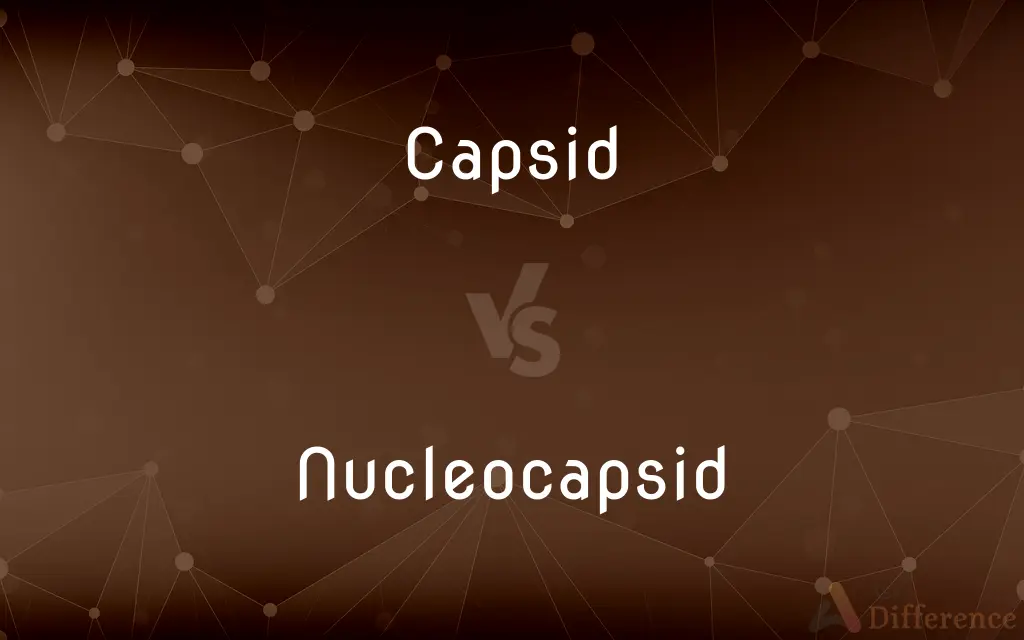Capsid vs. Nucleocapsid — What's the Difference?
Edited by Tayyaba Rehman — By Fiza Rafique — Updated on September 28, 2023
Capsid refers to the protein coat of a virus, while Nucleocapsid describes the combination of the viral genome and the capsid.

Difference Between Capsid and Nucleocapsid
Table of Contents
ADVERTISEMENT
Key Differences
Both Capsid and Nucleocapsid are terms used in virology, specifically referring to parts of a virus's structure. The Capsid is essentially the protein shell that surrounds the viral genome. It plays a vital role in protecting the genetic material of the virus and assists in infecting host cells. On the other hand, the term Nucleocapsid represents a higher order of assembly: it is the combination of the viral genome (either RNA or DNA) and the capsid.
In simpler terms, while the Capsid is just the protein coat, the Nucleocapsid encompasses both the coat and the genetic material it protects. In the life cycle of a virus, the Capsid facilitates the virus's attachment to and entry into host cells. Once inside the cell, the Nucleocapsid is often involved in replication processes, as it contains the viral genome required to hijack the cell's machinery.
Moreover, understanding the distinctions between Capsid and Nucleocapsid can be vital for the development of antiviral drugs and vaccines. By targeting the capsid, researchers can potentially stop a virus from entering cells. By understanding the Nucleocapsid, they can interrupt the virus's ability to reproduce.
To summarize, while both Capsid and Nucleocapsid are closely related in terms of viral anatomy, they refer to different structures. The Capsid is solely the protein coat, whereas the Nucleocapsid combines this coat with the encapsulated viral genome.
Comparison Chart
Definition
Protein shell of a virus
Combination of viral genome and its protein shell
ADVERTISEMENT
Contains
Only protein
Both protein and genetic material (DNA or RNA)
Role
Protects the viral genome and aids in infecting host cells
Involved in viral replication processes
Target in Research
Preventing virus from entering cells
Interrupting the virus's ability to reproduce
Relation to Viral Genome
Encloses the genome
Directly contains the genome
Compare with Definitions
Capsid
A protein coat surrounding the viral genome
The Capsid's integrity is crucial for the virus's survival
Nucleocapsid
The assembly of a virus's genetic material and its protein coat
The Nucleocapsid contains all the essentials for the virus to replicate
Capsid
The external layer of protein protecting a virus's DNA or RNA
The shape and design of the Capsid vary among different viruses
Nucleocapsid
A combination of viral RNA or DNA with the capsid
Researchers are targeting the Nucleocapsid to halt viral reproduction
Capsid
A protein structure encasing the genetic material of viruses
Without a functioning Capsid, the virus cannot infect host cells effectively
Nucleocapsid
The unit comprising a virus's genome enclosed by its capsid
The stability of the Nucleocapsid is critical for viral infectivity
Capsid
The protective protein shell of a virus
Researchers studied the structure of the Capsid to develop a new antiviral drug
Nucleocapsid
The sum of the capsid and the viral genetic contents
The Nucleocapsid's architecture is a focus in advanced virology studies
Capsid
The proteinaceous armor of a viral particle
Some drugs aim to dismantle the Capsid, rendering the virus harmless
Nucleocapsid
The core structure of a virus, containing both protein and genetic material
Viral replication processes are often initiated by the Nucleocapsid
Capsid
A capsid is the protein shell of a virus, enclosing its genetic material. It consists of several oligomeric (repeating) structural subunits made of protein called protomers.
Nucleocapsid
The nucleic acid of a virus together with the protein coat that encloses it.
Capsid
The protein coat that constitutes the shell of a virus particle.
Nucleocapsid
(biology) The core structure of a virus, consisting of nucleic acid surrounded by a coat of protein
Capsid
The outer protein shell of a virus
Capsid
A variety of leaf bug
Capsid
The outer covering of protein surrounding the nucleic acid of a virus
Common Curiosities
How does a Nucleocapsid differ from a Capsid?
A Nucleocapsid combines the capsid with the viral genome, while a Capsid is just the protein coat.
Does the Nucleocapsid contain the viral genome?
Yes, the Nucleocapsid contains either RNA or DNA of the virus.
Is the Capsid involved in infecting host cells?
Yes, the Capsid aids in attaching to and entering host cells.
Do all viruses have a Capsid?
All viruses have some form of protective covering, often referred to as a Capsid.
What is a Capsid?
A Capsid is the protective protein shell of a virus.
Why is the Capsid important for a virus?
The Capsid protects the viral genome and facilitates infection of host cells.
What role does the Nucleocapsid play in a virus's life cycle?
The Nucleocapsid, containing the viral genome, is involved in replication processes within the host cell.
Can the structure of the Capsid be targeted for drug development?
Yes, targeting the Capsid can potentially prevent a virus from entering cells.
How is the Nucleocapsid vital for viral replication?
It contains the viral genome required for hijacking the host cell's machinery.
Share Your Discovery

Previous Comparison
Slack vs. Slock
Next Comparison
Catacomb vs. CryptAuthor Spotlight
Written by
Fiza RafiqueFiza Rafique is a skilled content writer at AskDifference.com, where she meticulously refines and enhances written pieces. Drawing from her vast editorial expertise, Fiza ensures clarity, accuracy, and precision in every article. Passionate about language, she continually seeks to elevate the quality of content for readers worldwide.
Edited by
Tayyaba RehmanTayyaba Rehman is a distinguished writer, currently serving as a primary contributor to askdifference.com. As a researcher in semantics and etymology, Tayyaba's passion for the complexity of languages and their distinctions has found a perfect home on the platform. Tayyaba delves into the intricacies of language, distinguishing between commonly confused words and phrases, thereby providing clarity for readers worldwide.















































